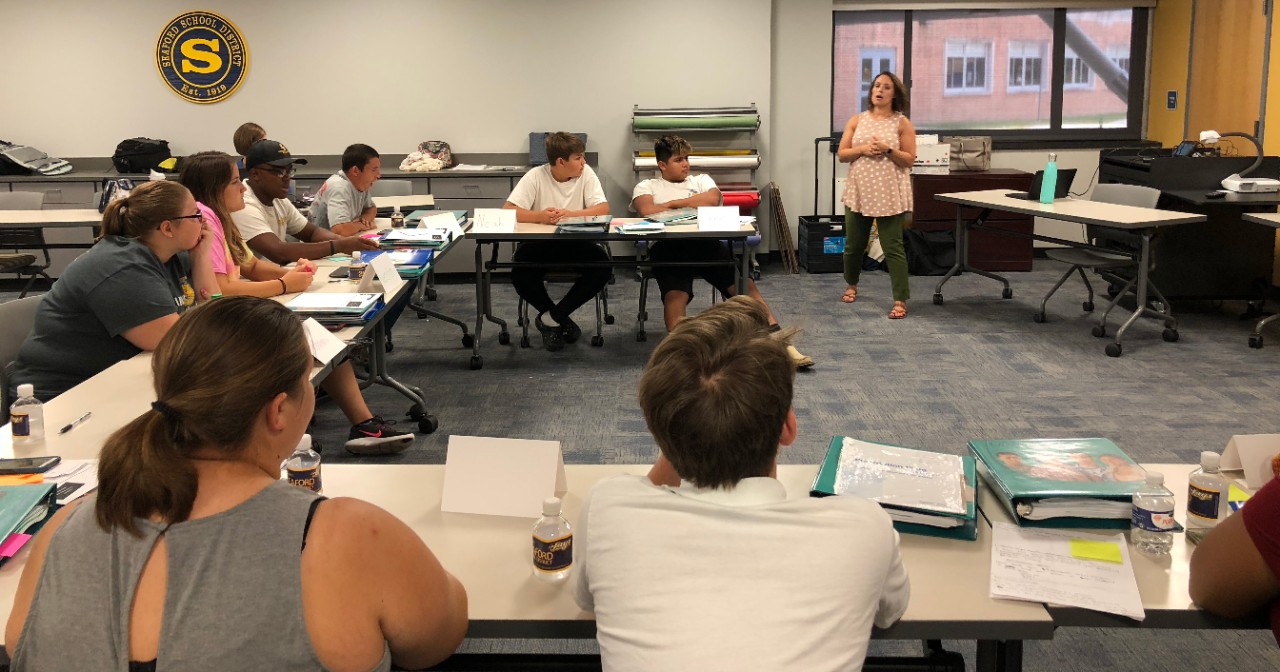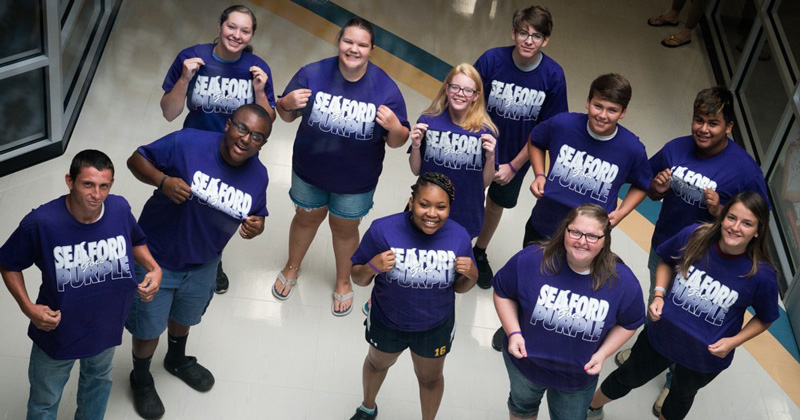

Tackling opioid abuse through peer-to-peer training
Photos by Elisabeth Wile and Michele Walfred August 29, 2018
UD Cooperative Extension trains Seaford students on preventing opioid abuse
When Seaford High School senior Tyesha Seymore heard about an opportunity to reduce the rising rate of opioid use in her community, she jumped at the chance. According to the State of Delaware’s Department of Health and Social Services, Delaware ranks ninth in the nation in drug overdose death rates. In substance abuse prevention programs, early education is viewed as extremely important.
“Since I am younger, I feel like I can connect better with the youth in our area,” said Seymore. “When I go to middle school to teach these kids, I hope they become leaders and spread the word.”
Seymore, along with 10 other Seaford High School students spent three days in August training as peer educators and health ambassadors. They will soon take their new knowledge into middle school classrooms as part of a new, national initiative — Well Connected Communities.
Seymore, along with 10 other Seaford High School students, spent three days in August training with University of Delaware faculty and staff to become peer educators and health ambassadors. Their training is part of a new, national initiative dubbed Well Connected Communities — an effort to cultivate wellness across the country. National 4-H Council and the Cooperative Extension System, which includes land grant institutions such as UD, is equipping volunteer leaders to help their neighbors be healthier at every stage of life. With the support of the Robert Wood Johnson Foundation (RWJF), the nation’s largest philanthropy dedicated solely to health, the goal is to cultivate wellness and foster a “culture of health” in communities across America.
In Delaware, the Sussex County Health Coalition identified Seaford as an innovator community — looking at how health needs of the community can be addressed in new, creative ways. The youth health ambassador and peer educator model is an example of that.
“Ten of the 11 students came from an existing school club structure — National FFA,” says Gina Crist, community health specialist with UD Cooperative Extension. (FFA stands for Future Farmers of America.) “The camaraderie and regular meeting space presented an ideal environment for follow-up with the students as the effort progresses.”
Once trained, the Seaford 11 will deliver Botvin LifeSkills Training (LST), a nationally recognized anti-substance abuse curriculum. Traditionally, Botvin is offered as a provider training model, with Delaware 4-H educators presenting the evidence-based program to adult teachers for presentation in middle school classrooms.
A new model
“We wanted to determine if youth ambassadors would be more effective in delivering the message than adult teachers,” Crist said. “Now we are rolling it out, keeping the fidelity of the curriculum intact, but using a new teaching method.”
As the first model in the country to use direct peer-to-peer education, everyone involved in the effort is eager to see the results. Pre- and post-tests will be analyzed by Botvin at the national level.
The first day of the Seaford students’ training focused on the Botvins LifeSkills Training Curriculum taught by Delaware 4-H Botvins educator Lindsay Hughes. Botvin’s interactive lessons emphasizes feedback, role playing, mindfulness and specific life skills designed to empower students to resist the pressures that often accompany making a wrong decision regarding violence, tobacco, alcohol or drug abuse. Botvin LST boasts a 75 percent reduction in drug use from their program.
“The students were great to work with and worked well together,” said Hughes. “I am excited to see the results from the peer to peer teaching that the youth will be participating in this school year.”
On the second day, Crist provided “Ages and Stages” classroom management techniques for teaching younger students. The Seaford 11 learned about diversity and different learning styles.
On the final day of training, the students heard real life stories of addiction and recovery. Sussex County Health Coalition’s Peggy Geisler and Lisa Coldiron, who introduced Seaford Goes Purple — a drug-free campaign launching in Seaford. Both presenters encouraged the students to extend their roles beyond the classroom as community leaders and health ambassadors in the Well Connected Community initiative — building the force of volunteers in the community working to make a change.
The students all volunteered for the effort and only later learned that they will also receive a stipend, through funding from the Sussex County Health Coalition.
“I hope that I can prepare our younger peers for the future and to make better decisions,” said senior Mackenzie Brown.
UD Cooperative Extension’s Michelle Rodgers, who also serves as the Well Connected Communities program director at the national level, traveled to Seaford to thank the students personally for their involvement.
“Our preliminary reach shows that it is far more effective, and makes way much more difference when peers hear from peers,” Rodgers said. “You are real kids and going to talk to real kids. You are some of the first in the country doing this, and the work you are doing is really important. We are going to be following the work you do, which will be a model for the rest of the country.”

Contact Us
Have a UDaily story idea?
Contact us at ocm@udel.edu
Members of the press
Contact us at 302-831-NEWS or visit the Media Relations website


